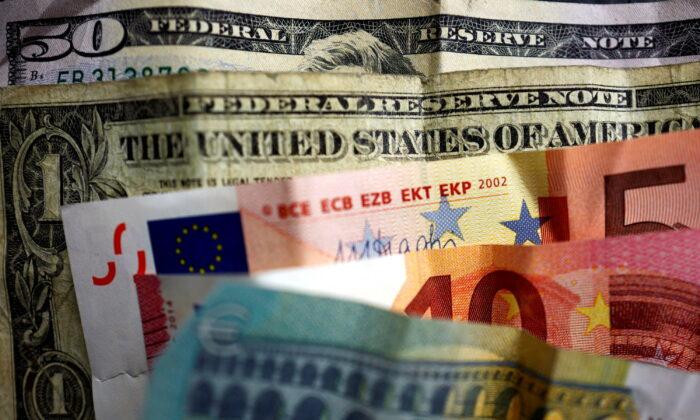LONDON—The dollar fell to its lowest in almost two weeks on Wednesday and the euro gained, with currency traders optimistic about peace talks in Ukraine, even amid warnings about the damage to Europe’s economy.
Equity markets were up in the Asian session, continuing a pick-up in sentiment on Wall Street as markets became hopeful that the Ukraine conflict could end— although this move ran out of steam as European shares opened in the red.
Russia promised on Tuesday to reduce its attack on Kyiv, but the United States said it had not seen “signs of real seriousness” from Russia in pursuing peace.
The dollar extended its losses on Wednesday, hitting a new thirteen-day low of 97.797, as investors changed their mind on their defensive bets.
At 1107 GMT, the dollar index was down 0.4 percent on the day at 97.993. The euro rallied against the dollar, with the pair up 0.4 percent at 1.113, having touched its highest in four weeks.
The risk-sensitive Australian and New Zealand dollars also gained, with the Aussie up 0.3 percent on the day at $0.7528.
“Markets appear to have taken an optimistic stance well before peace talks have yielded any result,” ING FX strategists wrote in a note to clients.
“The FX market may be increasingly detached from trading the Russia-Ukraine situation and start to catch up with the wide moves in rate and growth differentials, all of which point to a stronger dollar.”
Investors expect the U.S. Federal Reserve, which raised rates by 25 basis points at its March 16 meeting, to be more hawkish than the European Central Bank, driving the dollar higher against the euro.
The U.S. Treasury yield curve, widely watched as a barometer of the economy’s health, briefly “inverted” on Tuesday in a warning that bond investors see a recession on the horizon. But analysts attributed the dollar weakness to improved risk appetite, rather than a loss of confidence in the United States’ economy.
“When it comes to the FX market impact, the inversion is likely to play out more through a near-term cap in how high U.S. 2-year yields can go as opposed to prompting risk-off pricing due to concerns over a U.S. recession,” said Simon Harvey, head of FX analysis at Monex Europe.
In Europe, data and policymaker warnings highlighted stalling growth, plummeting confidence, and soaring inflation as the European economy feels the heat from the war in Ukraine.
Spain’s flash CPI data for March showed prices rising at their fastest since May 1985. But ECB President Christine Lagarde said food and energy prices should stop rising, helping the eurozone avoid the combination of stagnant growth and high inflation feared by economists.
The German government’s council of economic advisers slashed its growth forecast for Europe’s largest economy, citing economic uncertainty due to Russia’s invasion of Ukraine.
The yen staged a recovery from its recent seven-year lows, after a meeting between Bank of Japan (BOJ) Governor Haruhiko Kuroda and Prime Minister Fumio Kishida added to speculation about the level of official discomfort with a falling yen.
At 1115 GMT, the dollar was down 0.9 percent on the day versus the yen, at 121.83, compared with the pair’s recent high of 125.105 hit on Monday.





